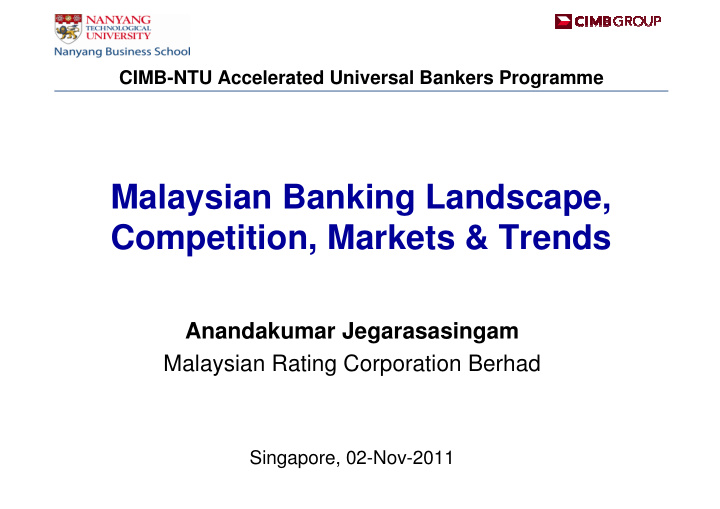



CIMB-NTU Accelerated Universal Bankers Programme Malaysian Banking Landscape, Competition, Markets & Trends Anandakumar Jegarasasingam Malaysian Rating Corporation Berhad Singapore, 02-Nov-2011
Presentation Outline • Economic and operating environment • Structure of the banking sector and regulation • Performance of the banking sector • Islamic banking • Current issues • Household sector debt • Concluding remarks 2
Economic and Operating Environment
Challenging Macro Environment � International Environment � Sovereign debt woes and geo-political uncertainties. � Commodity price volatilities and spill over effect into the real economy. � Weak international trade conditions. � Policy Environment � Inflation and monetary policy dilemmas. � Increased regulatory scrutiny. � Domestic Operating Environment � Saturating domestic market and intensifying competition. � Escalating household sector debt. � Improved corporate performance; however, uncertainties linger. 4
Economic Growth Outlook ��������������������������������������� ����������� �������� ��� �� �� �� �� � � �� ����� ����� ����� ����� ����� ����� ����� ����� ����� ����� ����� ����� ����� ����� ����� ����� ��� ��� ������ �!"#! � After staging a recovery from 2Q09 to 1Q10, Malaysia’s real GDP growth is showing signs of moderation. � However, Malaysia’s GDP growth still remains reasonably healthy compared to more developed economies. � Official estimates for real GDP growth is in the range of 5.0%-5.5% for 2011 and 5.0%-6.0% for 2012. 5
Economic Drivers ������������������ ��������������������������������� ���� !��()��)������( 1���2��) .)/��( ����&� ��� ��� %&�� #�'�()�* ���+���( ��� ��� �� � � 1����& �� � �� -��'� ���$ ���� ���� ���� ���� %&�� �� �$� �� 0������ �� ��� ������ �%�,� ������ ��%�, � Contraction in industrial output in 2009 dragged overall economic growth down during the year. � However, the rebound in growth in 2010 was supported by a strong recovery in the industrial sector and the improved showing of the services sector. 6
Export Driven Economy � Malaysia’s economy is export driven, with exports accounting for 110% of GDP in 2010 (2009: 107%). � Correlation between Malaysia’s real GDP growth and real exports was nearly 90% for the period 1Q2000 to 2Q2011. � There is a strong link between the Malaysian economy and the US economy as well. Correlation between US ISM and Malaysia’s export growth is about 64% for 7 the period 2001 and 2011.
Key Macroeconomic Indicators �������������������������������� ����� (������ �#����������)��#�� *� �6�)���)� ��������+��)�'�(���� ��� ��� �3�� �� �$ � �� �3�� �� .�)� ��+� ���� 4��� 0�5� 1��� %6�� 1�*� 4��� 4��� %�&� ��6� .�)� ���� ���� ���� ���� ���� ���� ���$ ���� ���� ���� ���� �� �� �� �� �� �� �� �� �� �� �� �� �� � ������ �!"#! ������ �!"#! '�#�������������������������� !��"�����������#�$����������%��&� 96)�����������5�(���(�����3�0����4��������5�(���(�����3 ,�(��7��'��&���)� ��� ��� %+���&��7��'��&���)� � � $ $ � � � � 4����� 4����� 4����� 4����� 4����� 4����� 4����� 4����� �� 4����� 4����� 4����� 4����� 4����� 4����� 4����� 4����� ������ ��,��8���&����1���*(�� ������ ��,��8���&����1���*(��� 8
Other Statistical Indicators $������� �+��������� ����������*��#����������� �$���������!����"����%�������������� �$���������!����"����%�������������� ��� ��� $� �� �� � �� $ �� � �� � �� � � ���� ���� ���� ���� ���� ���� ���� ���� ���� ���� ���� ���� ���� ���� ������ �,����5��&� ������ �,����5��& %��&����������������������'�"���"����� ��������������������������� : ��� ����� � �$��� � ����� � ���� � ���� � � ���� ���� ���� ���� ���� ���� ���$ ���� ���� ���� ���� ������ %6���� %�&��� ������ %6���� %�&��� ������ %6���� %�&��� ������ ������ �!"#!� ������ �!"#! 9
Economic Transformation Programme � The economic transformation programme (ETP) announced by the government intends to uplift Malaysia into a high income nation by increasing per capita income from USD6,700 in 2009 to USD15,000 in 2020. � Focus on 12 national key economic areas that will receive prioritised public investment and policy support. � The ETP is estimated to attract investments to the tune of MYR1.4 trillion. � Private sector to provide 92% of investments. � Domestic sources to provide 73% of investments. � The ETP is also expected to create 3.3 million additional jobs. � As of July 2011 committed investments amounted to MYR170 billion (12% of target). 10
Investment Climate Malaysia’s private investments Projects awarded and construction growth (%) (index rebased to 100 at bottom cycle) 130 40.0% 10.0% 30.0% 9.0% 125 20.0% 8.0% 120 10.0% 7.0% 0.0% 6.0% 115 -10.0% 5.0% 110 -20.0% 4.0% 105 -30.0% 3.0% -40.0% 2.0% 100 No of projects awarded (LHS) -50.0% 1.0% 95 Construction output growth -60.0% 0.0% 4Q 08 2Q 09 4Q 09 2Q 10 4Q 10 2Q 11 1Q 2Q 3Q 4Q 1Q 2Q 3Q 4Q 1Q 2Q 09 09 09 09 10 10 10 10 11 11 � Budget 2012 – bullish on private investment, based on the post-global- financial-crisis momentum. � But the pace of projects awarded declined significantly, dragging construction growth down in 2Q2011. 11
Business Environment � The World Bank’s ‘Doing Business’ survey of 183 countries ranks Malaysia as the 18th easiest country to do business. 12
Interest Rate Environment ����������������������������� '������������������������ ,�(��7��'��&���)� %+���&��7��'��&���)� .�� ��� ��� � � �3� � $ �3� � � �3� � � �3� � � 4����� 4����� 4����� 4����� 4����� 4����� 4����� 4����� 4����� 4����� 4����� 4����� 4����� 4����� 4����� 4����� ������ �,��8���&���1���*(�� ������ �,��8���&����1���*(�� � Policy interest rates and the statutory reserve requirement (SRR) were lowered during the global financial crisis as a countercyclical measure. � The low interest rate environment facilitated credit expansion, while the reduction in SRR freed up much needed liquidity. � However, since March 2010 the overnight prime rate (OPR) has been on a rising trend, while SRR has returned back to the pre-crisis level. 13
Structure of the Banking Sector & Regulation
Recommend
More recommend